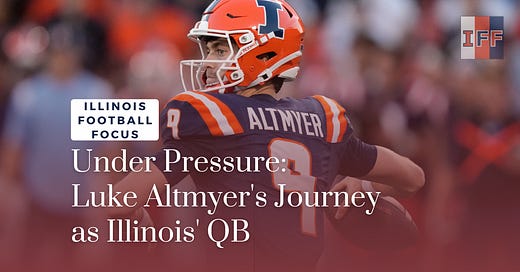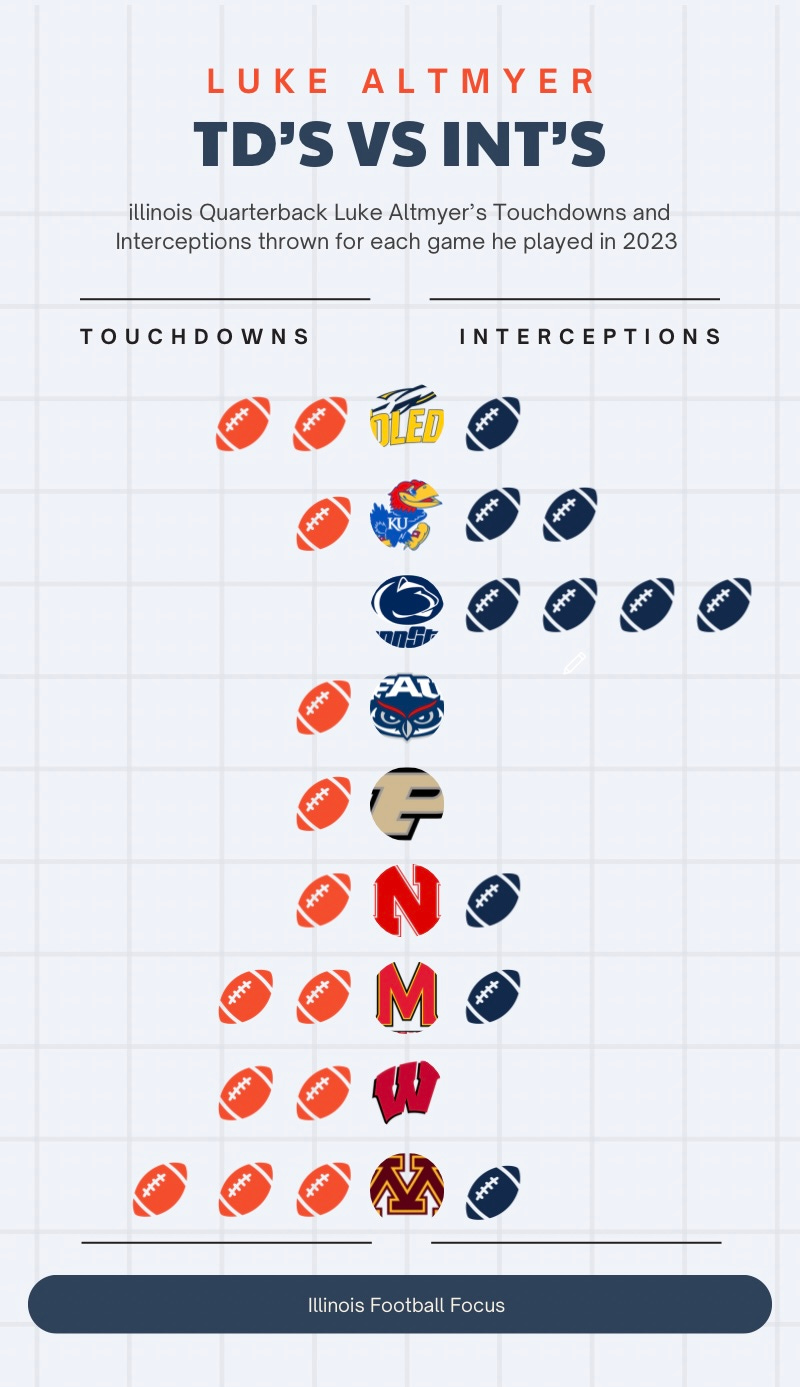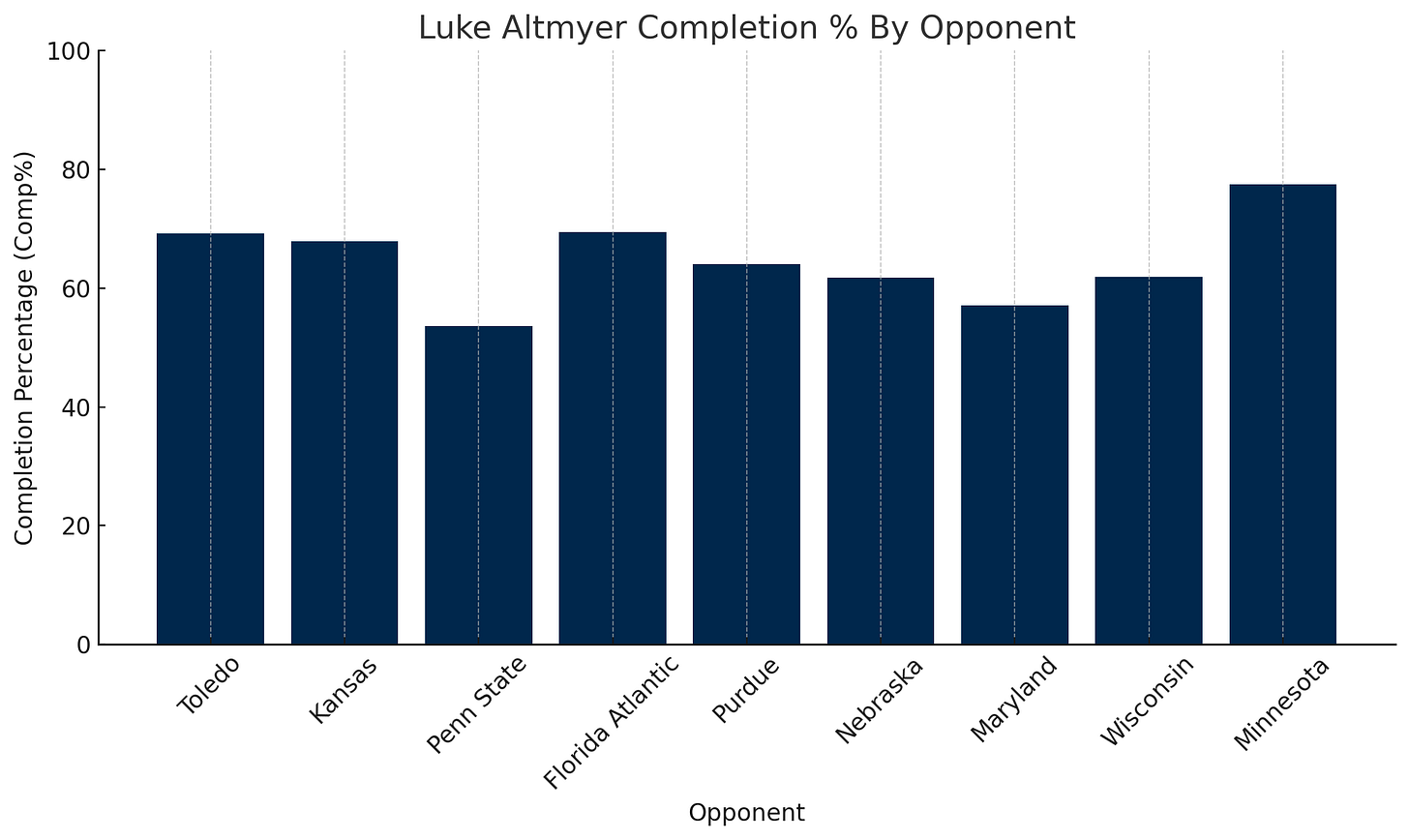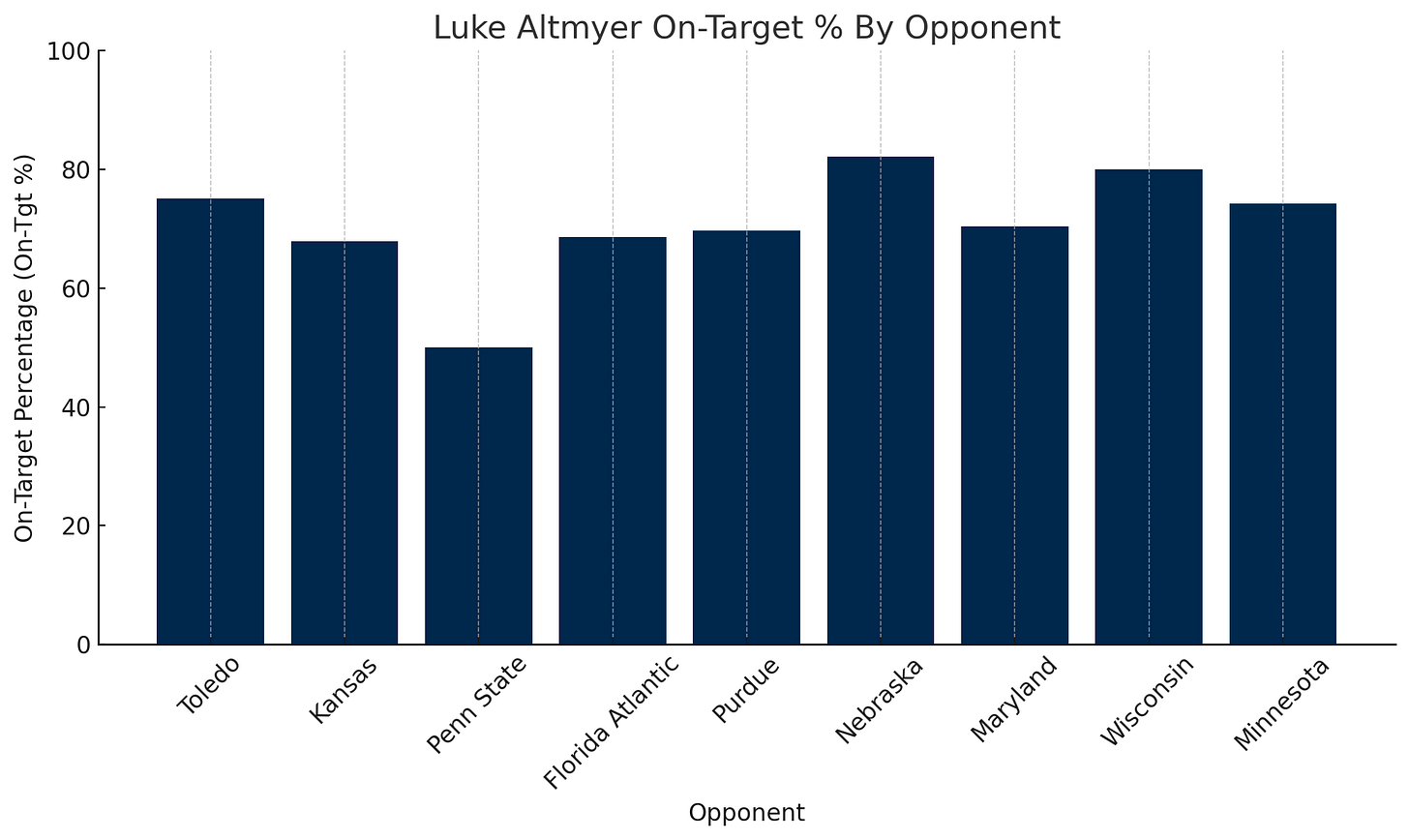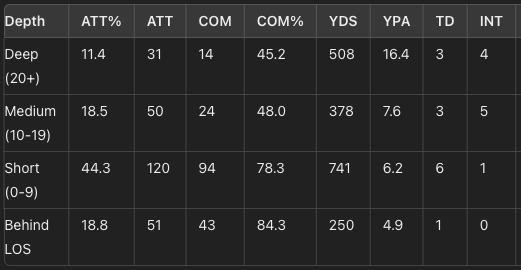Under Pressure: Luke Altmyer's Journey as Illinois' QB
A Comprehensive Analysis of Altmyer's First Season as a College Football Starter
In this post, I will delve into some of the stats, share my findings, and then summarize what we learned along with my opinion of Luke Altmyer at the end.
Quarterback Luke Altmyer started nine games as a sophomore last season for Illinois. When evaluating him, it is important to remember that last season was his first as a college football starter. Luke had a combined 54 passing attempts in two seasons with Ole Miss compared to 270 attempts with Illinois.
One common criticism among fans is Luke Altmyer’s interceptions. It’s similar to the reaction I get when I tweet about Ty Rodgers—someone always comments, “but he can’t shoot.” Similarly, whenever I tweet about Luke Altmyer, I often receive comments about his ten interceptions. This was the second-highest in the Big Ten, behind Taulia Tagovailoa. However, interceptions are just one statistic. Illini great Juice Williams threw 44 interceptions in his career, including 16 in his junior year, yet he is remembered fondly by fans.
This was also Luke’s first season as a college football starter. Let's examine how he progressed throughout the season in terms of touchdowns versus interceptions.
First Three Games
Three Touchdowns
Seven Interceptions
Last Six Games
Ten Touchdowns
Three Interceptions
When looking at his performance on a week-by-week basis, the criticisms about his interceptions seem unfair. He significantly improved in this area as he gained more experience throughout the season. Additionally, he was playing behind the 117th ranked pass-blocking team in Division I and the worst pass-blocking team in the Big Ten. While throwing four interceptions in a single game isn’t ideal, it’s important to consider the context. This wasn’t a player who consistently struggled with interceptions throughout the season. Although the improvement in taking care of the ball may come with its negatives. I believe Luke became somewhat gun-shy. While this helped reduce his turnovers, it also limited his aggression and led to more sacks.
The next major challenge for Luke Altmyer was the presence of John Paddock, who set passing records, made big plays, and captivated the state. As a fifth-year senior, Paddock compensated for the subpar pass blocking by getting the ball out faster than any other Big Ten quarterback, with an average time to throw of 2.4 seconds. In comparison, Altmyer faced criticism for his slower release, even though he was actually in the middle of the pack among Big Ten quarterbacks.
Let’s compare Paddock and Altmyer in some other stats.
Stat Glossary in footnotes.1
What really stands out when comparing the two is Paddock's ability to limit pressures and sacks. As a fifth-year senior, Paddock processed the game at a high level, knowing when and where to get the ball out and demonstrating the pocket presence to buy himself a little extra time.
However, Luke also shines in his own right, boasting the fifth-best completion percentage in the Big Ten and the second-best catchable pass percentage.
Granted, he did have the shortest average depth of throw among all Big Ten quarterbacks, which likely boosted his accuracy stats. Overall, though, Altmyer was a middle-of-the-road Big Ten QB, with the ninth-best PFF passing grade and the tenth-best PFF offensive grade among the 18 Big Ten QBs who played enough to be qualified.
He ranked ninth in big-time throws, fourth in adjusted completion percentage, and third-best in turnover-worthy play percentage. This last stat measures the percentage of his total throws that resulted in a turnover-worthy play. Third! Hopefully, the “he throws too many interceptions to be good” crowd doesn't see that stat. While his short depth of target and conservative approach helped limit turnover-worthy plays, it's still impressive that a first-time full-time QB1 as a sophomore in the Big Ten managed to limit these plays so effectively. Ironically, this is one of the main criticisms he faces from fans.
However, let's examine the right side of the chart below to identify some warranted criticisms.
Stat glossary in footnotes2
Mm-noom-ba-deh
Doom-boom-ba-beh
Doo-boo-boom-ba-beh-beh
Pressure pushin' down on me
Luke Altmyer had the song "Under Pressure" by David Bowie and Queen on repeat last season. He was second to last in the percentage of pressures that turned into sacks, with 26.4% of his pressures resulting in a sack, a higher rate than any other Big Ten quarterback except for Northwestern’s Brendan Sullivan (33.3%).
He was also second to last in the percentage of pressures with some responsibility, meaning these weren't all just the fault of the offensive line. When under pressure, he had the 14th best PFF passing grade. However, on dropbacks where he was kept clean, Altmyer had the 6th best PFF passing grade. Compared to every QB when they are kept clean, Luke was the 6th best at passing.
We are starting to piece together a picture of Luke Altmyer, but let's dive into some game-by-game stats to see if we notice any trends.
Luke had three games in the “good” tier, three games in the “average” tier, and three games in the “poor” or worse tier. Historically, Illinois QB play has typically been at the bottom end of the Big Ten in terms of talent. However, we are starting to see many stats where Luke Altmyer appears to be an average, middle-of-the-pack Big Ten QB. Achieving this in his sophomore season is exciting for the future of this Illinois team.
His NFL passer rating per game was much more consistent later in the season. For this stat, 100 is deemed a pretty good passer rating.
The Penn State game was particularly rough for Altmyer.
Catchable%: Percent of passes that were catchable, according to SIS Video Scouts.
Impressive first two games throwing a catchable ball on over 95% of his throws.
On Target%: The number of on-target/catchable throws a quarterback makes divided by the total number of pass attempts.
While his last two games were his best, this is where Luke Altmyer struggled and should be the main area of improvement to look for this upcoming season.
uke Altmyer was sacked 34 times last season, the most in the Big Ten. While the pass blocking was subpar, sacks can often be the QB’s fault as well.
Now, let's get into some Twitter questions before we summarize what we’ve learned about Luke Altmyer.
his is doable via PFF.com, and they actually have a cool chart that helps illustrate this. Luke threw a lot of short 0-9 yard passes and was not very aggressive with the long ball, even though we know he has the arm for it. Luke Altmyer’s 82.3 PFF passing grade on short passes was the second-best among Big Ten QBs.
Here are his PFF passing ranks by depth among Big Ten quarterbacks:
Deep - 10th
Intermediate - 9th
Short - 2nd
Behind LOS - 5th
Looks like Altmyer favored the short over the middle pass and performed better throwing to his right than throwing to his left.
We’ve established that while Luke Altmyer’s average time to throw was much longer than John Paddock’s, it was still middle-of-the-road among Big Ten QBs.
Now, let’s look at the data. The orange line represents the average time to throw each game, while the blue bars represent the total passing yards.
That Wisconsin game sure looks rough.
While there was some correlation between passing yards and total time to throw, this correlation is exaggerated by the Wisconsin game. Not to go all Tim Beckman here, but if we exclude that Wisconsin data point, there isn’t much correlation at all.
Now, let’s look at the PFF grades for the offensive linemen and Altmyer’s performance. We will compare the team’s pass-blocking grade for each game to Altmyer’s passing grade.
A correlation coefficient of 0.673 does indicate a moderate to strong positive correlation. Typically, when the pass blocking grade was worse, so was Altmyer’s passing grade.,
Now, I’m going to attempt to put everything together and summarize my thoughts on Luke Altmyer based on his play last season and the data.
We know Luke Altmyer has a strong arm and can provide value with his legs when running the ball. I also believe he’s a relatively accurate quarterback, which is why I might be higher on Altmyer than others. The physical tools are there. He isn’t limited by poor arm strength or by being an “oak tree” unable to scramble and make something out of nothing.
I’m not worried about the interceptions. If anything, I’m more concerned that he is too worried about throwing interceptions, which might have caused him to be too timid and not optimize his performance. I’ve seen Luke throw the ball; he can throw it all over the field and place the ball well.
The main issue that keeps coming up is the pressures and sacks. That is the chief concern. Fans need to be more aware of this if Illinois is going to improve offensively next season. So, let’s talk about the pressures and sacks.
What causes them? For one, we have to mention the offensive line. They had the worst pass-blocking grade in the Big Ten per PFF. Illinois did not have a solid right tackle, and it really hurt the team. Eventually, they had to move Isaiah Adams from LG to RT. Imagine we’re playing CFB 25 the video game and considering switching Isaiah Adams’ position. He might be an 85 overall rating left guard, but moving him to right tackle drops him to a 74 overall. The offensive line gets worse, but Illinois had to do it and play Adams out of position because all their other right tackle options were below a 70. Adams had to sacrifice to raise the offensive line’s floor, and the line really struggled. This was surprising, as Bret Bielema is known for winning games through great play in the trenches. Yet, this is something a sophomore QB had to deal with, which doesn’t set him up for success.
But pressures and sacks are also a QB stat. Luke needs to improve his ability to process the game faster, make quicker reads, and move through his progressions. He also needs to manipulate the defense more effectively. We saw Paddock do this a lot. On the touchdown pass to Isaiah Williams vs. Minnesota, Paddock stared down Casey Washington post-snap. This manipulated one of the best safeties in the game, Tyler Nubin, into creeping up and shading towards Washington. It was all a mirage. Paddock moved in the pocket to bait the Washington throw and buy more time as Isaiah Williams took the top off the defense. Paddock then unloaded for the game-winning touchdown just before taking a sack. Do I think Luke Altmyer makes that play? Probably not. Luke might have been able to force the ball into a tight window to make a play to Casey Washington, as he did on multiple big plays last season, but to do what the fifth-year senior John Paddock did vs. Minnesota, I don’t think so. Manipulating the defense to create an open target can help limit sacks. Having more pocket presence, standing tall, and making small movements to avoid pressure would have been beneficial. It would have been nice to see them call more rollout passes last season for him to mitigate poor line play. The good news is that a lot of this is mental. With more reps, increased comfort, and a slower game pace, these are all areas he can work on and improve in his second season under Barry Lunney Jr.
For this piece, I looked up a lot of stats. While I only posted the main ones I thought people might be interested in, I reviewed many more. In most of those, Luke Altmyer was middle-of-the-road. Illinois isn’t used to having QBs that are average Big Ten players. This is a step up. The team’s quarterback play is improving because of Luke Altmyer’s performance relative to past Illinois QBs. So, when I see Illinois has a middle-of-the-road quarterback in the league, I see that as a sign of progress for the program. Now, let’s add the fact that Luke Altmyer has two more seasons of eligibility left. Two more years to improve, gain experience, and get both the physical and mental reps needed to enhance his game. There are reasons to be excited.
Last season, Illinois had an average offense and below-average defense and went 5-7 missing a bowl game. This upcoming season, I expect Illinois to be a much better pass-blocking team. They will have more talent and depth. Combine that with a second season of Luke Altmyer and Kaden Feagin, and two senior WRs in Pat Bryant and Zakhari Franklin, and the Illinois team could reasonably have an above-average offense. If the defense can reach league average, then Illinois is likely going bowling next season.
Do I expect Luke Altmyer to be the best QB in the Big Ten and win a bunch of awards? No. Do I think Luke Altmyer can be an above-average QB in the Big Ten? Yes. Luke’s an average QB now, with his main issues being things that typically improve with experience and reps. I expect the Illinois offense to be in the top half of the Big Ten next season, and Luke Altmyer will be a significant reason for that.
All the stats in this post were via PFF and Sports Info Solutions.
On Target% - The number of on-target/catchable throws a quarterback makes divided by the total number of pass attempts.
Catchable% - Percent of passes that were catchable, according to SIS Video Scouts.
TD% - Percent of passes resulting in touchdown.
Int% - Percent of passes resulting in touchdown.
Sack% - Percent of dropbacks resulting in a sack.
Pressure% - Percent of dropbacks under pressure
Big Time Throw Rate - the % of passing attempts that were a big time throw
Turnover Worthy Play Rate - the % of passing attempts that are turnover worthy plays
Adjusted Completion Percentage - Includes WR drops that regular completion % wouldn’t count but as it was a WR issue, we give the QB credit for those with this stat.
% Of Pressures With Some Responsibility - This looks at out of the pressures, who had some fault at hand. The left tackle, the left guard, the QB, Etc. As a stat above, this looked at what percent of total pressures did Altmyer have some fault in it or responsibility for that pressure.

